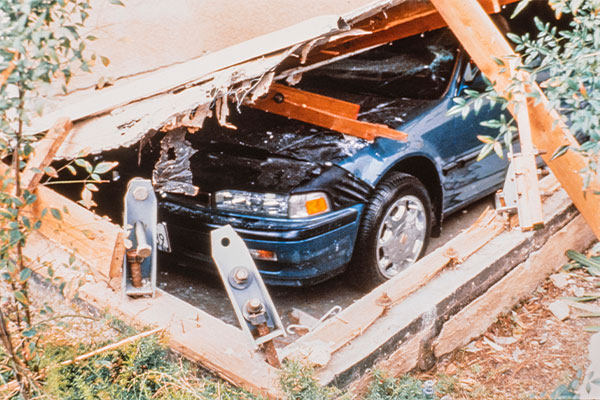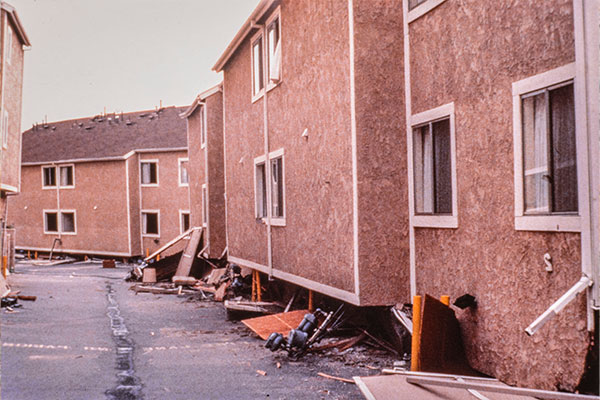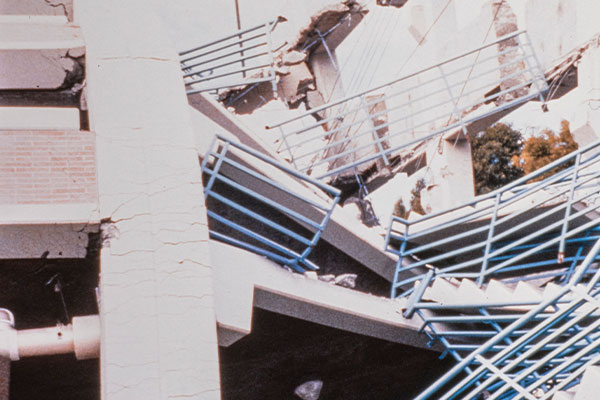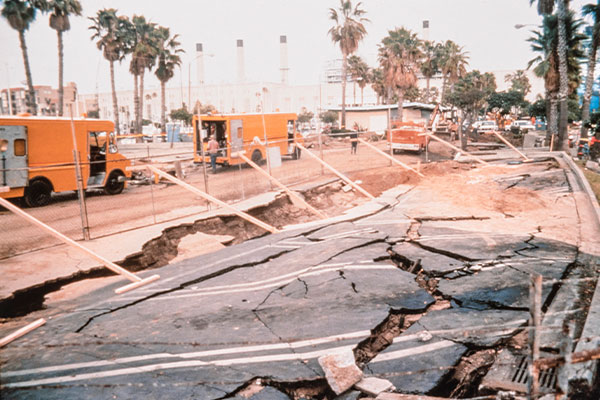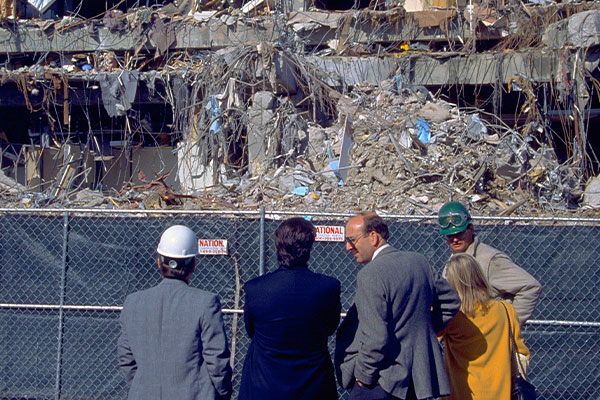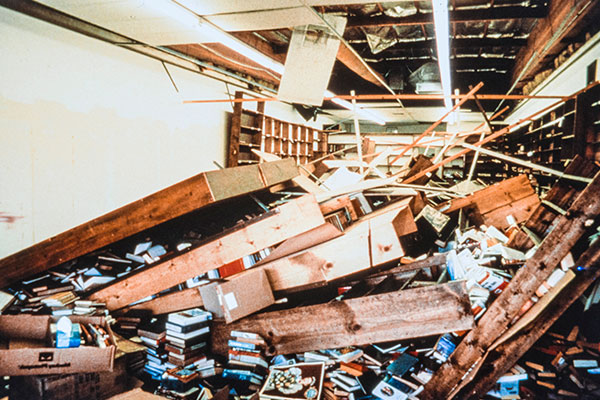How the Northridge Quake Changed CA Earthquake Preparedness and Building Codes
On January 17, 1994, the Los Angeles area was shaken awake at 4:31 AM by the Northridge earthquake. The California Department of Conservation states that the magnitude 6.7 quake killed over 50 people and caused massive structural damage.
The SCEDC reports that the Northridge earthquake “produced the strongest ground motion ever instrumentally recorded in an urban setting in North America.” With $20 billion in property damage and a total economic loss over $40 billion, Northridge holds the title as the costliest earthquake in American history, according to the California Department of Conservation.
The Northridge Earthquake: A Brief Overview of Damage
According to the Southern California Earthquake Data Center, the epicenter was in the San Fernando Valley, one mile south-southwest of Northridge on a blind thrust fault known as the Pico Thrust Fault (aka Northridge Thrust Fault).
Catastrophic damage was extensive. The special report, Resilience by Design, by the City of Los Angeles cites that damage included the loss of 49,000 housing units, of which two thirds were soft story construction. The National Institute of Standards and Technology reported that somewhere between 80,000 to 125,000 people were temporarily or permanently displaced from their homes because of damage.
Here are five lessons learned from Northridge:
Lesson 1: The Importance of Seismic Retrofitting
FEMA calls older, unreinforced buildings the “single biggest seismic risk in the United States.” Seismic retrofitting can help make homes more resistant to earthquake damage.
Raised foundation homes built before 1980 are especially vulnerable to earthquake damage, as most are not adequately bolted to their foundations. Houses with living space over the garage, post & pier footings, and those built on hillsides are also at risk of earthquake damage. As noted in the Resilience by Design report, many soft story structures collapsed during the 1994 Northridge earthquake. Other buildings were knocked off their foundations and unreinforced masonry fell to pieces.
Seismic retrofits can help prevent costly damage to your home. Read about CRMP’s seismic retrofit grant programs to see if you qualify for financial assistance.
There’s no way to guarantee that your home won’t suffer damage in an earthquake, but there are ways to help reduce the risk.
An Earthquake Soft-Story (ESS) retrofit reinforces homes with living space over the garage. In an ESS seismic retrofit, the foundation is bolted to the frame of the house, perimeter walls of the lowest story are braced, and the walls at the garage door (or any other large opening) are strengthened with plywood, steel, or other proprietary elements.
An Earthquake Brace + Bolt (EBB) retrofit helps prevent homes with a raised foundation or crawl space beneath the ground floor from sliding or toppling off its foundation during an earthquake. In an EBB seismic retrofit, the foundation is “bolted” to the frame of the house, and any crawl space walls under the home are “braced” with plywood.
Lesson 2: Improvements in Building Codes
In the report Resilience By Design, former LA County Mayor Garcetti said, “Almost all earthquake deaths result from the failure of human construction. Through the application of stronger building code requirements… we have reduced much of the risk to our lives.” He added, “A building is only as good as the code that was in place when it was built.”
Los Angeles made these changes following Northridge:
- New unreinforced soft-story and non-ductile concrete building construction is no longer permitted.
- Mandatory retrofit programs were introduced for non-ductile concrete and wood-frame soft-story buildings built before 1978.
Retrofits for Existing Concrete & Wood-Framed Buildings
After the Northridge earthquake occurred, the California Seismic Safety Commission conducted extensive research and published the Northridge Earthquake: Turning Loss Into Gain. The report addresses structural deficiencies as well as the lack of modern building codes. It also includes recommendations for retrofits and improvements to existing structures, a call for new legislation for building standards, and stricter contractor licensing requiring seismic safety principles.
If your home was built prior to the year 2000 and has not been retrofitted, it may have seismic vulnerabilities. Contact a licensed contractor to schedule an inspection. They can identify structural weaknesses in your home and work with you to plan an appropriate retrofit.
Qualifying California homeowners may also qualify for a grant to assist with the costs of a seismic retrofit. Find out if your home qualifies!
Lesson 3: Enhanced Emergency Preparedness and Response
According to the report The Northridge Earthquake and its Economic and Social Impacts, 104 emergency service stations were operational immediately after the earthquake, and local safety departments organized inspection teams. But challenges remained. The report says computer aided dispatch was down for 7 hours and lack of access to water in some areas made it difficult for crews to put out fires caused by the earthquake.
The Northridge earthquake revealed many areas of unpreparedness. Going forward, state and local governments worked together to develop emergency disaster preparedness plans that addressed earthquake mitigation strategies, immediate response, and long-term recovery.
Emergency services may not be available right away in a major event like Northridge. It’s important to know what to do before, during, and after an earthquake, have an emergency kit ready and accessible, and strengthen your home now to reduce the threat of damage later.
Lesson 4: The Economic Impact and the Need for Insurance
According to estimates in the Northridge Earthquake and its Economic and Social Impacts report, 67% of all direct losses were uninsured. Only 40% of homeowners carried earthquake insurance. Without insurance, renters and homeowners were on their own to cover expenses.
Insurance companies struggled to cover the billions in losses. In 1996, the California Legislature created the California Earthquake Authority (CEA)—a not-for-profit, publicly managed, privately funded entity. Residential property insurers could offer their own earthquake insurance or become a CEA participating insurance company.
There is no way to prevent earthquake damage from occurring, but you can take steps to minimize the risk by retrofitting your home and getting earthquake insurance to help cover any losses that do occur. Seismic retrofits come with a price, but they could save you money in the long run by helping to reduce the risk of major damage to your home, like sliding off the foundation or structural collapse. The good news? California homeowners that meet program qualifications can get financial assistance to cover retrofit costs. See if you qualify now!
Lesson 5: The Valuable Role of Public Awareness and Education
Public education campaigns were used to increase awareness and help improve individual and community response.
The Great California ShakeOut
This annual statewide earthquake drill was inspired by Northridge. The public safety campaign teaches Californians how to protect themselves during earthquakes.
Drop, Cover, & Hold On
The Drop, Cover, and Hold On campaign teaches the safest and most immediate actions to take during a large earthquake.
Seven Steps to Earthquake Safety
The Earthquake Country Alliance presents a 7-step approach to earthquake preparedness, including tips on safety, emergency supplies, and details on how to create a disaster plan.
California Office of Emergency Services (Cal OES)
Cal OES's role expanded significantly after the Northridge earthquake. Cal OES now operates as a central coordinating body for disaster response and preparedness.
A Catalyst for Change
The challenges faced after Northridge highlighted the importance of safer structures, better coordination among emergency agencies, and comprehensive disaster preparedness plans. The Northridge quake served as a catalyst for significant improvements in building codes and emergency response systems in California and throughout the rest of the country. These changes have helped reduce earthquake risk and increase the overall resilience of our communities.
It’s not a matter of if another big earthquake will hit California, but when. Reduce your earthquake risk by retrofitting your home. You may be able to reduce retrofit costs by securing a grant from CRMP. We have two seismic retrofit grant programs for qualifying CA homeowners in high-risk areas including the Earthquake Brace + Bolt (EBB) grant program and the Earthquake Soft-Story (ESS) grant program.
Visit our Seismic Strong Blog for more earthquake retrofit and preparedness information, and read the 7 Essential Earthquake Safety Tips.

